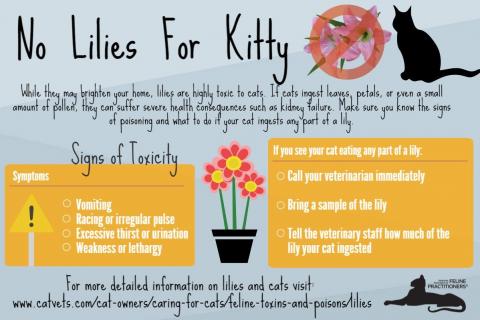Animal Accidents: Keep lilies away from your cats this Easter

Despite having some measure of self-respect, many of us here at Accident Data Center voluntarily place ourselves into the ownership of cats. If you, like us, are currently the property of a feline, please be aware that Easter lilies are extremely toxic to cats.
The website Pet Poison Hotline classifies lily toxicity as “moderate to severe” for cats. Symptoms include:
-
Lack of appetite
-
Lethargy (as in, extraordinary lethargy--we're talking about cats here)
-
Hiding
-
Vomiting
-
Diarrhea
-
Halitosis (bad breath)
-
Dehydration
-
Inappropriate urination or thirst
-
Seizures
-
Death
OK, let’s hope you notice the other ones before “death.” Geez. According to the American Association of Feline Practioners, symptoms will develop within 6 to 12 hours of exposure.
The really really bad lilies for your cat are ones belonging to the Lilium or Hemerocallis species. I never took botany, and you probably didn’t either, so I will quote the experts directly:
The more dangerous, potentially fatal lilies are true lilies of the Lilium or Hemerocallis species. Examples of some of these dangerous lilies include the tiger, day, Asiatic hybrid, Easter, Japanese Show, rubrum, stargazer, red, Western, and wood lilies – all of which are highly toxic to cats! Even small ingestions (such as 2-3 petals or leaves) – even the pollen or water from the vase – can result in severe, acute kidney failure.
Good thing cats only ever drink out of vessels intended for them, so no need to worry about them drinking vase water, at least. Thank goodness. I know that, I, for one, don’t have the water running in my bathtub constantly because some people can’t drink out of a bowl (or cat fountain purchased specifically for them).
Three lilies are classified as “benign,” the Peace, Peruvian, and Calla lily. Apparently “benign” for Pet Poison Hotline means that your cat will merely suffer from “minor signs such as tissue irritation to the mouth, tongue, pharynx, and esophagus,” and possibly occasional “drooling, pawing at the mouth, foaming, and vomiting.” I suppose all of this is better than death, so, sure, let’s call it benign.
Another dangerous flower is the Lily of the Valley, but I’ve seen Breaking Bad, so I already knew that. While the lily of the valley will not cause kidney failure, it can cause potentially fatal heart arrhythmias in both cats and dogs (and shocking plot twists in the case of AMC dramas).
If you see your benevolent overlord eating a lily or exhibiting any of the above-mentioned symptoms while lilies are in your home, bring both the cat and the plant to the vet immediately (detailed emergency instructions can be found here). The vet will be able to treat your cat through various decontamination methods. It’s important that intravenous fluids are given within an 18-hour window for the best chance of a full recovery for your cat, as well as the best chance of forgiveness from your master for bringing poison disguised as a delicious puking aid into your home.
Safe, Non-toxic Alternatives for Easter Flowers:
Roses, sunflowers, tulips, irises, carnations, mums, baby’s breath, hyacinth, and daffodils.Resources:
The ASPCA details which plants are safe for your pet, poison safety tips, and much more.
Pet Poison Helpline is a 24-hour animal poison control service available throughout the U.S., Canada, and the Caribbean for pet owners and veterinary professionals who need assistance with treating a potentially poisoned pet. Keep in mind that they charge a $49 per incident fee, so try your local vet first.
Finally, to relate this to human safety, don’t let your cat drive.

Add new comment